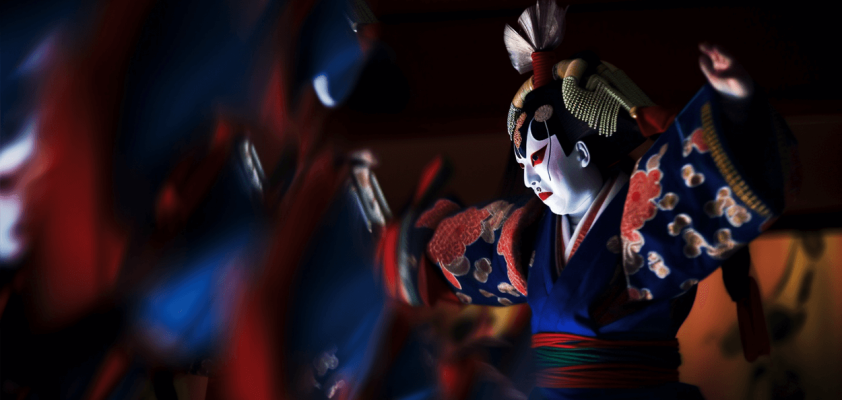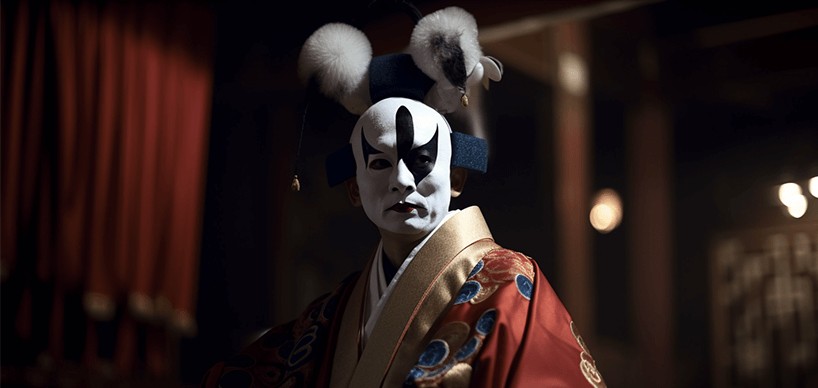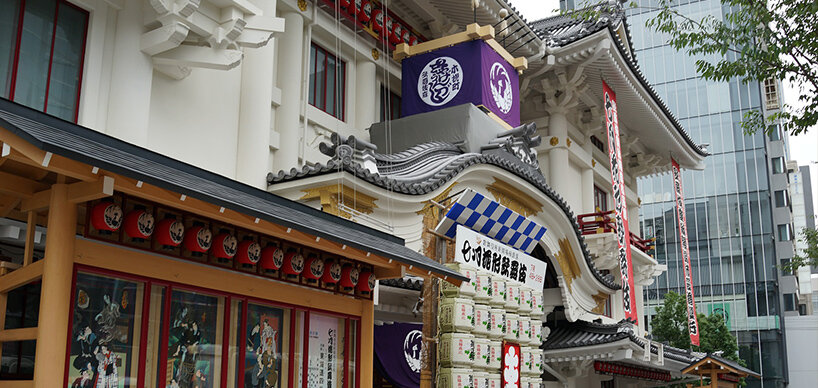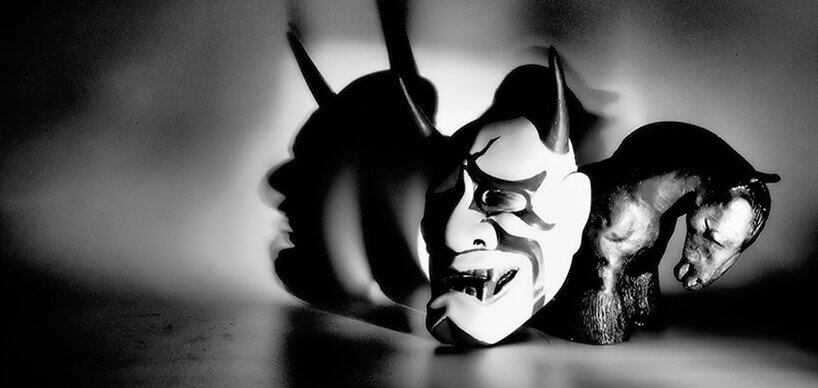Kabuki | Drama, eccentricity and transformations

Flowing costumes, vivid makeup, and hypnotic music? All that is Kabuki. One of the three major forms of the 400-year-old Japanese theater is a unique experience. A brief introduction to the world of Japanese acting.
Colorful world of Japanese theater
Kabuki is not easily forgotten. The vibrant makeup, men in women's costumes, and elaborate acting - behind all of this is much more than meets the eye. Elements like dance movements, facial expressions, and dialogues all follow their own set of rules.
What sets Kabuki theater apart from other forms? In Noh, there are masks and singing, in Bunraku, almost life-sized puppets. And Kabuki itself is a blend of acting, dance, and music, accompanied by traditional costumes, instruments, expressive facial expressions, and gestures. The bizarreness might have given this theater its name: Kabukimono roughly translates to "eccentric person" and refers to gangs of rovers who caused outrage on the streets of Japan until the early Edo period. The actual Japanese characters for Kabuki 歌舞伎, however, each mean "singing," "dancing," and "ability."
The way to Kabuki
Actors must work hard for many years to master all these elements. Many start very young: that's why you sometimes see six-year-olds making their debut on stage. Some are born into a family of Kabuki performers or find a successful actor to sponsor them. Others undergo training at the National Theater in Tokyo, which they can only begin at the age of 15. In these three years, aspiring actors learn the fundamentals of Japanese theater. Strict hierarchies still exist today, with leading roles often inherited based on lineage. Some established performers have even been designated as Living National Treasures of Japan.

Kabuki has another uniqueness: Only men are found on the stage. At the beginning of Kabuki history, the cast consisted entirely of women. However, in 1629, they were officially banned from Kabuki. This was because previous actresses were prostitutes and advertised themselves, leading to public altercations. Hence, male actors take on female roles in the plays, known as Onnagata. After the ban on women, Wakashu Kabuki ("Young Man Kabuki") emerged, featuring male prostitutes. Even though they were the forerunners of Onnagata, this form of Kabuki theater was soon prohibited as well. In the mid-17th century, only older men were allowed to perform for a while. This theater has evolved into a pure form of art, and although the age of the actors no longer matters today, actors are just that: actors.
Journey to another world
Fundamental to every piece in Kabuki theater is the story it tells. This can include historical events, love stories, traditional dramas, or mystical tales, for example. Some plots are well-known, while others become clear to the audience only when they understand the symbolism behind them. Among the most famous is the story of the 47 Ronin and their revenge for the death of their master. Today, actors have around 400 pieces in their repertoire, sharing some narratives with Noh and Bunraku theater.

Not every Kabuki style involves exaggerated roles. In Wagoto, dialogues and realistic acting dominate. Instead of lengthy dialogues, Shosagoto primarily focuses on dance, depicting the plot through movement. Sewamono pieces are set in modern times, while historical performances belong to the style of Jidaimono. Other categories are identified by primary plot elements: revenge in Sogamono, ghost stories in Kaidanmono, and when the main character is a thief or rogue, it's called Shiranamimono.
The stage makes the performance: The surroundings are equally important for the overall effect. In some pieces, a huge painting of a pine tree decorates the background of the stage. This represents traditional stories with spiritual symbolism borrowed from Noh theater. For particularly impactful entrances, there is the Hanamichi, a path leading from the stage through the audience rows. Rotating stage elements, trapdoors, and backstage exits additionally contribute to special effects.
Roles with recognition value
An experienced audience can quickly discern the personality, status, and significance of a character: from the color and design of their costume, the makeup, and the movements. The dialogues are often written in an old Japanese that not even every native speaker understands, so the actors must support it with their expressiveness.
There is a distinction between male and female roles. Princesses wear red kimonos with delicate golden embroideries. Oiran, high-ranking and respected courtesans, must stand out in a wide and splendid kimono. Often, such costumes weigh over 30kg and are dyed in a way to maximize their impact under stage lights. Geisha, on the other hand, are recognized by modest and monochromatic yet unique costumes.
Here, kimonos with their patterns often symbolize the changing seasons in the plot. The way the obi belt is tied signifies something about the social status of the role: tied in a diagonal bow for samurai servants, loosely hanging for young women of noble birth, and folded like a "box" for wives of samurai and nobles. Heavy wigs with distinctive hair accessories complete the costume. Traveling women wear a special hat, and if you spot a purple headband, the character is typically ill - often due to love. If you look closely, you can also identify props from a bygone century: hand mirrors, Tenugui towels, and soap pouches that were used in the Edo era. Being historically accurate is essential in Kabuki.
Samurai, ghosts and demons
Male roles are called Tachiyaku and are equally diverse. Clothing also plays a decisive role here: Vibrant costumes belong to young characters, while Samurai lords wear simple yet impressive kimonos with family crests. The colors black and white hold special significance. Important characters wear dark costumes to emphasize their roles. For Ronin, for example, the contrast between a black kimono and a white face is particularly striking. White, the color of death, is reserved for ghosts and characters who will commit ritual suicide.

Picture Credits: Author:TumOng | Shutterstock | License
Male roles are called Tachiyaku and are equally diverse. Clothing also plays a decisive role here: Vibrant costumes belong to young characters, while Samurai lords wear simple yet impressive kimonos with family crests. The colors black and white hold special significance. Important characters wear dark costumes to emphasize their roles. For Ronin, for example, the contrast between a black kimono and a white face is particularly striking. White, the color of death, is reserved for ghosts and characters who will commit ritual suicide.
The wig also represents specific characters: Only villains have a messy hairstyle, and the most powerful samurai have a bald forehead with a hair knot at the back, secured with wax. The face, in turn, speaks its own language. The makeup is designed to highlight the eyes, mouth, and sometimes muscles for strong facial expressions, with slightly different accents depending on the role. Bright makeup with lots of red emphasizes supernatural characters. These belong to the Aragoto style of Kabuki theater, where a superhero protects weaker characters from villains.
Each actor applies their own makeup before their big performance. Initially, special wax is applied to the face, followed by the white makeup. Using brushes, they complement it with black, red, and blue to suit the role. Assistants are trained to efficiently dress each actor in costume and wig.
The thread pullers in the background
As crucial as costume and acting is the music in Kabuki. Performers and singers can tell the story in a form of narrative singing, or "long song" (Nagauta). Joy, sorrow, love, pain, and humor: all are found in the expressive power of these songs.
The dance and singing that define this theatrical form are accompanied by traditional instruments. Classic is the Shamisen, a type of Japanese lute. The group of Shamisen players, sitting in the background, is called Hayashi. Using large and small drums, musicians create additional tension at the right moment and announce the beginning and end of an act. When a villain reveals their true nature, you hear a bell. Wooden clappers come into play in dramatic moments when actors swing their swords or when the audience's attention needs to be directed to something. There are even sound effects: fans, flutes, and wooden wheels, for example, mimic rain, bird chirping, and thunder. Imagination plays its part.
To ensure everything runs smoothly on stage, there are also the so-called Kurogo. With their black costumes and stealthy movements, they resemble ninjas: The black signifies that they are not part of the play but rather bring and remove props and assist the actors.
One must not forget numerous craftsmen and artists who take care of the backgrounds, kimonos, wigs, fans, paper umbrellas, and other small props. Behind every performance are dozens of staff members and centuries-old tradition.
Experience Kabuki theater for yourself

Since the Edo period (1603 - 1868), this art form has existed. Twenty years after this era, in 1898, Japan's largest theater was opened: the Kabukiza Theater in Tokyo. There, performances by the most renowned actors in the country take place almost daily. If you want to watch one, be sure to book your ticket early, as they sell out quickly! Outside of Tokyo, you can also see performances in Kyoto, Osaka, and other major cities.
Such a performance usually consists of three or four acts, with intervals between each. Tickets can be purchased for an entire performance, about four hours, or for individual acts. Each act tells a different story, and the genres are chosen to provide the audience with a variety of entertainment. During the intervals, people eat, drink, and browse the souvenir shop.
Kabuki is traditionally a popular theater form and is meant for entertainment, so there's no need to dress too formally - although you will still find spectators in kimono or suits at Kabukiza. If you don't speak Japanese, don't worry: For 500 yen (almost 4 euros), you can get a small tablet with the English translation of the dialogues. The program with the plot summaries helps you experience the story like a local.
Today, this cultural heritage is not limited to Japan alone: In the United States, for example, famous actors have also showcased their art. Japanese theater, with its uniqueness, expressiveness, and timeless stories, has gained fans worldwide. Anyone can enjoy Kabuki and thus get to know Japanese culture in its most vibrant facets.
Perhaps you are also interested in the article about the hidden world of Geisha?











-from-the-yakiyaki-grill-pan.jpg)




